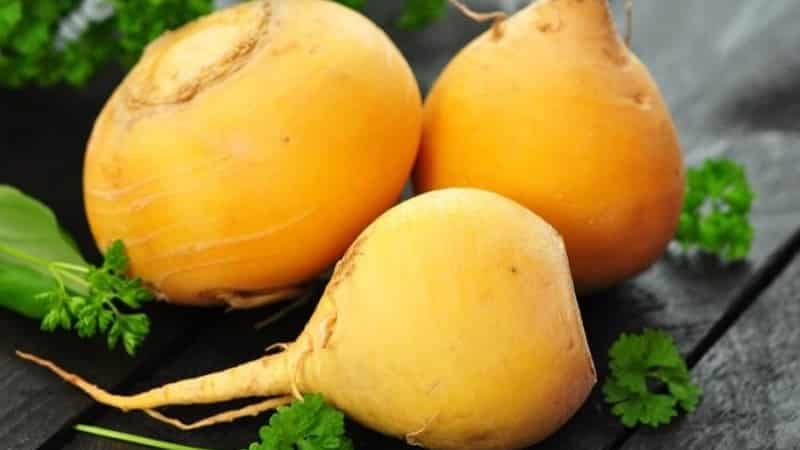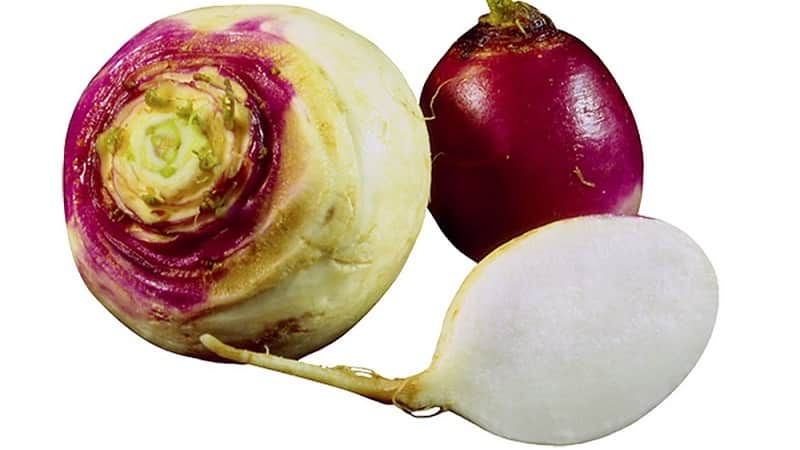What is the difference between rutabaga and turnip
It is generally accepted that rutabaga and turnip are the same vegetable. They are similar in appearance and taste, and are successfully grown by domestic gardeners on their plots. However, these are different vegetables with specific features and characteristics. What is the difference between rutabaga and turnip? We will explain in detail below.
Description and characteristics of crops
Turnips and rutabaga belong to the cabbage family., although they don’t look like cabbage at all.
Turnip
Turnip - perennial plant. In the first year of growth, a basal rosette and root crop are formed round or elongated shape with a diameter of 3-7 cm.

In the second year, the plant forms a flower shoot ― produces a long stem 1.5 m with a peduncle. From the peduncle comes a fruit - a pod - and inflorescences in the form of a shield with light yellow petals, which contains seeds.
The vegetable is unpretentious. There are 2 types of turnips grown: regular and fodder turnips., which is called turnip. The roots are flat or flattened, ranging in size from 700 to 900 g.
Interesting! Turnips were grown in ancient Rome. Its harvest was no less valuable than the wheat harvest. Some root vegetables reached impressive sizes and weighed up to 16 kg. It is believed that it was from the large-fruited forms that its fodder varieties subsequently appeared.
Root crops are shallowly sunk into the soil and have a light yellow, pink or greenish color. The pulp is juicy, sweetish, slightly tart, and usually tastes bitter if there is a lack of moisture. The tops are low, abundant, purple or copper in color.
Swede
Swede is a hybrid of turnip and cabbage. Belongs to the same family and genus as turnips. The development of a plant follows the same pattern: in the first summer it gains leaf mass and forms an edible root crop, in the second summer it forms a peduncle and seeds.

The root crop is dense, green or reddish in color, oval-cylindrical or round in shape, similar to beets. A rosette of basal foliage develops in the garden bed around the root crop.
Important! Rutabagas have a more valuable mineral composition and are superior to turnips in the content of iron, phosphorus, potassium and sulfur. It contains carotene and vitamin C, which makes it resistant to long-term storage.
The most delicious thing about the root vegetable is hidden under the thick skin - juicy, fleshy pulp There are two types of light shades: light yellow goes to people’s tables, and white goes to livestock feed.
The taste of the root vegetable is milder than that of turnips, without pronounced bitterness. Gardeners often prefer rutabaga, because, in addition to taste, it has high nutritional value and medicinal properties.
How is turnip different from rutabaga?
Similar at first glance vegetables differ in a number of ways.
Appearance
The main external difference between these vegetables is the size and color of the root vegetables.. Rutabagas are similar to beets, the same round, with a reddish skin at the top, at the base of the leaf part, with an abundant leaf rosette. However, oval and cylindrical shapes are not uncommon. The pulp is dark, rich yellow.
The taste is mild, without bitterness. Turnips have a less delicate taste and tougher flesh, and often have a slight bitterness. The root vegetable is smaller in size, light yellow, milky or black (“Swedish turnip”).
Interesting! Every year in Switzerland there is a rutabaga festival on the shores of Lake Zurich.Many figurines made from rutabaga, the production of which annually takes about 30 tons of selected root vegetables and 50 thousand candles, illuminate the surroundings of the town of Richterstvil. On the day of the celebration, traditionally at 8 pm, the city lights are turned off, and the entire city is illuminated with lanterns made of hollow rutabaga with carved patterns. This colorful parade moves through the streets of the city, accompanied by music and dancing.
Chemical composition
The value of any product is usually determined by its chemical composition. Turnips and rutabaga are almost identical in this regard, but there are differences.

Calcium is the predominant mineral in turnips.. Unlike rutabaga, it contains succinic acid, sugars and vitamin PP. Turnips are slightly less nutritious: the calorie content of the root vegetable is 32 kcal per 100 g of product, and the rutabaga has a calorie content of 34 kcal per 100 g.
Rutabaga is chemically richer in minerals and vitamins. Its pulp contains pectins, B vitamins, and carotene. There is less calcium in it than in turnips, but there is iron, magnesium and sulfur. Ascorbic acid in rutabaga is not lost even during long-term storage and can withstand prolonged cooking.
Application
Turnip has an analgesic and antiseptic effect, can prevent premature graying and baldness. Turnip dishes used to slow down the development of eye diseases. The raw vegetable is a source of calcium.
Turnip relieves symptoms of rheumatism and arthritis. Due to its low sugar content and the presence of glucoraphanin, it is useful for diabetics. Turnip decoction relieves toothache and eases toothache. respiratory diseases. Thanks to its diuretic effect, turnip relieves swelling.
Attention! Eating turnips raw is not recommended for people with gastrointestinal and genitourinary problems.
Despite its food purpose, rutabaga has become popular among the population precisely as a food product.. The feed option remains turnip, which is grown for these purposes all over the world.
In addition to being nutritious, rutabaga has a number of beneficial properties.. Expectorant and diuretic tinctures are prepared on its basis. A particularly popular medicinal smoothie is a root vegetable ground in a blender with honey and lemon. To relieve cough, take 1 tbsp. l. 3 times a day with a glass of warm water. Rutabaga juice, squeezed in a juicer, mixed with rosehip infusion or cranberry juice, helps with dry cough.
Fresh rutabaga juice is also used to heal wounds, burns, and pustular skin lesions.. In folk medicine, rutabaga is used to prevent pancreatic diseases, edema, atherosclerosis, liver and kidney diseases.
Attention! You should not eat raw rutabaga if you have inflammation of the intestines and gallbladder and acute form of hepatitis.
Salads made from raw root vegetables have a positive effect on metabolic processes in the body and remove cholesterol. Raw rutabaga helps cleanse blood vessels and prevents the development of atherosclerosis. Due to its high calcium content, rutabaga is useful for people suffering from softening of bone tissue; it is eaten to strengthen teeth.
Rutabagas, like turnips, use also baked, boiled and stewed. Fresh rutabaga tops are added to salads, and dried tops are added to soups and sauces.

Origin
Until the 18th century, turnips in our country were on the table every day for both the poor and the rich.. But then the root crop was completely replaced by foreign potatoes.The French and Italians still use turnips in everyday and haute cuisine. It is fried, consumed baked and raw, not only as root vegetables, but also as green tops.
Rutabaga appeared by chance, by crossing wild cabbage with one of the turnip varieties. The Mediterranean is considered to be its place of origin. The first mention of this culture comes in 1620. In this year, the famous Swedish scientist K. Baugin in his works first mentions the vegetable, which then received a second name - “Swedish turnip”.
According to another version, rutabaga comes from Siberia, from where it later came to the Scandinavian Peninsula. This fact is supported by its natural frost resistance. In the wild, this root vegetable grows as a weed only in certain areas of North Africa.
Conclusion
In Russia, turnips and rutabaga are practically forgotten as food products due to their simple and unusual taste. Dishes made from rutabaga and turnips are most often salads and medicinal tinctures.
With the passing of Russian ovens into history, steamed turnips have become exotic on our tables. Although this is an extremely healthy product, when baked it is easily absorbed by the body. Rutabaga is even recommended for baby food in certain recipes.